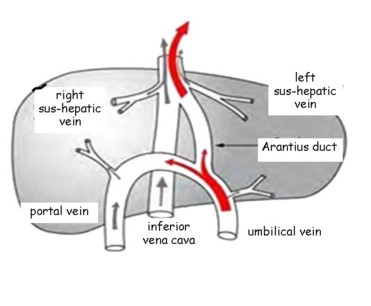Very rare. The Arantius duct (ductus venosus) is the fetal vessel that directly connects the left umbilical vein and the portal vein to the inferior vena cava, near its entry into the right atrium. About 20-30 % of the umbilical venous blood passes through this vessel, hence avoiding the hepatic portal network. Because of its low caliber, this vessel creates an acceleration (from 15cm/sec in the umbilical vein up to 75cm/sec at the exit of the canal) of the oxygenated umbilical blood flow at its entrance in the R.A., which promotes preferential passage through the foramen ovale, the left ventricle and the cerebral and coronary arteries.

In case of agenesis of the Arantius duct, the umbilical venous blood can reach the right atrium,
- either via an extrahepatic pathway with a direct connection to the R.A. (36 %), the inferior vena cava, an iliac vein or the azygos vein: risk of cardiac failure in utero with hydrops fetalis and/or polyhydramnios
- either by an intrahepatic pathway through the portal network and the hepatic sinusoids.
The prognosis for an isolated agenesis of the Arantius duct is good, but there is a risk of
- agenesis of the portal vein: in case of extrahepatic drainage
- congenital type 1 or 2 portosystemic shunt (9 %) (see this term): especially in case of intrahepatic drainage. Risk of encephalopathy, pulmonary hypertension, hepatopulmonary syndrome, hepatic tumours
The agenesis of the Arantius duct is often associated with:
- a cardiac defect: cardiomegaly, VSD
- other abnormalities: Turner, Noonan or Down syndromes
Anesthetic implications:
echocardiography: malformation, pulmonary hypertension, cardiac failure ? risk of portal hypertension or portosystemic shunt
References :
- Jaeggi ET, Fouron J-C, Hornberger LK, Proulx F et al.
Agenesis of the ductus arteriosus that is associated with extrahepatic umbilical vein drainage : prenatal features and clinical outcome.
Am J Obstet Gynecol 2002 ; 17 :1031-7.
- Takechi K, Kitamura S, Fujii S, Soutani M et al.
Delayed emergence from anaesthesia in a patient with agenesis of the ductus venosus.
Anaesthesia Cases 2014; 2:80-3.
- Moomba RS, Frommelt M, Moe D, Shillingford AJ.
Agenesis of the venous duct : two cases of extrahepatic drainage of the umbilical vein and extrahepatic of portosystemic shunt with a review of the literature.
Cardiology of the Young 2015 ; 25 : 208-17.
Updated: February 2021